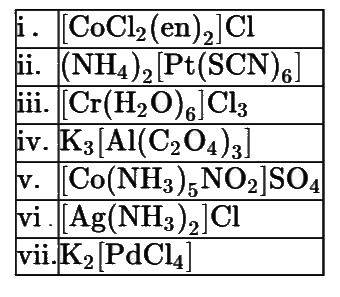Write true or false: Ambidentate ligands can show linkage isomerism .
The correct Answer is:T
Step-by-Step Solution:
1. Understanding Ambidentate Ligands:
- Ambidentate ligands are ligands that have two different atoms that can donate electron pairs to the central metal atom in a coordination complex. However, they can only coordinate through one of these atoms at a time.
2. Linkage Isomerism:
- Linkage isomerism occurs when a ligand can attach to a metal center in more than one way. This is particularly relevant for ambidentate ligands, as they can form different isomers based on which atom is used for coordination.
3. Example of Linkage Isomerism:
- Consider the complex (Pd(PPh3)2(NCS)2) and (Pd(PPh3)2(SCN)2). Here, the NCS (thiocyanate) ligand can coordinate through either the nitrogen (N) or the sulfur (S) atom, leading to two different isomers:
- In the first complex, NCS coordinates through nitrogen.
- In the second complex, SCN coordinates through sulfur.
4. Conclusion:
- Since ambidentate ligands can coordinate through different atoms, they can indeed show linkage isomerism. Therefore, the statement "Ambidentate ligands can show linkage isomerism" is True.
Final Answer:
True
---
- Ambidentate ligands are ligands that have two different atoms that can donate electron pairs to the central metal atom in a coordination complex. However, they can only coordinate through one of these atoms at a time.
- Linkage isomerism occurs when a ligand can attach to a metal center in more than one way. This is particularly relevant for ambidentate ligands, as they can form different isomers based on which atom is used for coordination.
- Consider the complex (Pd(PPh3)2(NCS)2) and (Pd(PPh3)2(SCN)2). Here, the NCS (thiocyanate) ligand can coordinate through either the nitrogen (N) or the sulfur (S) atom, leading to two different isomers:
- In the first complex, NCS coordinates through nitrogen.
- In the second complex, SCN coordinates through sulfur.
- Since ambidentate ligands can coordinate through different atoms, they can indeed show linkage isomerism. Therefore, the statement "Ambidentate ligands can show linkage isomerism" is True.
True
Topper's Solved these Questions
- COORDINATION COMPOUNDSBOOK - CENGAGE CHEMISTRY ENGLISHCHAPTER - COORDINATION COMPOUNDSEXERCISE - Archives (Linked Comprehension)
5 Videos
- COORDINATION COMPOUNDSBOOK - CENGAGE CHEMISTRY ENGLISHCHAPTER - COORDINATION COMPOUNDSEXERCISE - Archives Multiple Correct
1 Videos
- COORDINATION COMPOUNDSBOOK - CENGAGE CHEMISTRY ENGLISHCHAPTER - COORDINATION COMPOUNDSEXERCISE - Exercises Fill The Blanks
32 Videos
- CHEMICAL KINETICSBOOK - CENGAGE CHEMISTRY ENGLISHCHAPTER - CHEMICAL KINETICSEXERCISE - Archives Subjective
23 Videos
- D AND F BLOCK ELEMENTSBOOK - CENGAGE CHEMISTRY ENGLISHCHAPTER - D AND F BLOCK ELEMENTSEXERCISE - Archives Subjective
29 Videos
Similar Questions
Knowledge Check
Which of the following cannot show linkage isomerism?
ANO−2BSCN−CCN−DNH3
The ambidentate ligand among the following is
View SolutionWhich is the pair of ambidentate ligand?
View SolutionAn example of ambidentate ligand is
View SolutionWhich of the following complexes show linkage isomerism ?
View SolutionHow many among the following can exhibit linkage isomerism?

View SolutionThe complex that can show optical isomerism is:
View SolutionAre the bidentate ligands same as the ambidentate ligands ?
View Solution
